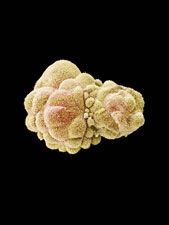URL: http://www.nature.com/cgi-taf/DynaPage.taf?file=/nature/journal/v408/n6815/full/408897a0_fs.html
Date accessed: 06 February 2001
Nature 408, 897 - 898 (2000) © Macmillan Publishers Ltd.
![]() 21/28th
December 2000
21/28th
December 2000
PETER ALDHOUS
Biology is continually throwing up ethical dilemmas. And the thorniest issue of 2000 was that surrounding research on human embryonic stem cells.
These cells can, in theory, give rise to any of the body's tissues — and so have enormous potential in regenerative medicine. But 'pro-life' activists are bitterly opposed to their use, as cultures of embryonic stem cells can only be created by destroying a pre-implantation human embryo.
JOE
READLE/NEWSMAKERS/EYE OF SCIENCE/SPL |
|
Culture shock: with George W. Bush installed in the White House, US stem-cell researchers may turn to using adult stem cells, such as bone marrow stem cells (right), rather than embryonic cultures. |
Campaigners against embryonic-stem-cell research have made much of experiments suggesting that adult stem cells, which reside in and help regenerate many tissues, can give rise to a much wider variety of cell types than was thought. Given this remarkable plasticity, they argue, attempts to develop stem-cell therapies should not need human embryonic stem cells.
This unexpected phenomenon became well known in 1999, when a team led by Angelo Vescovi of the San Raffaele Hospital in Milan showed that neural stem cells taken from the brains of mice, cultured, and injected into bone marrow could give rise to apparently normal blood cells1. This finding has proved difficult to replicate. But the past year has seen further demonstrations of plasticity, including two papers earlier this month that showed the reverse transformation — mouse bone-marrow stem cells giving rise to cells that resemble neurons2, 3. Vescovi's group encored in October by showing the mouse and human neural stem cells could produce muscle cells4.
Although these experiments hint that adult stem cells have great therapeutic potential, most researchers in the field argue that this may never be realized if the door to research on human embryonic stem cells is closed. The problem, they say, is that stem-cell science is in its infancy — its practitioners know little of the molecular mechanisms that underlie the plasticity of stem cells, or that cause them to travel down particular developmental pathways. For some tissues, they are still arguing over the precise identity of the stem cells involved. "We're in the Dark Ages," observes Leonard Zon, a developmental biologist at the Children's Hospital in Boston.
YORGOS
NIKAS/SPL |
|
Divide and conquer: embryonic stem cells could be a source of any tissue type. |
Ron McKay, a stem-cell biologist at the National Institute of Neurological Disorders and Stroke in Bethesda, Maryland, believes that the potential of adult stem cells will vary from disease to disease. "It depends absolutely on what you're interested in," he says.
For liver regeneration, work in mice suggests that adult stem cells have great clinical promise: in November, researchers with the company StemCells in Sunnyvale, California, cured animals of a lethal liver disease by transforming bone-marrow stem cells into liver cells5. Preliminary data from humans are also encouraging6.
But McKay's work, on therapies for Parkinson's disease that require the production of neurons that release the neurotransmitter dopamine, suggests that adult stem cells have their limits. McKay can generate large numbers of dopamine-producing neurons from mouse embryonic stem cells7, but he has so far failed to achieve this using adult neural stem cells.
Researchers agree that the key to developing therapies is the fundamental understanding needed to drag the field out of its Dark Ages. And although this process is still in its early days, some papers published in 2000 gave chinks of light.
For instance, it is becoming clear that signals requiring cell-to-cell contact help determine stem cells' eventual fate4, 8. Meanwhile, researchers are starting to discover the intracellular factors involved. In March, a team at the Massachusetts General Hospital showed that a protein called p21 is vital for maintaining bone-marrow stem cells — without it, the cells proliferate rapidly and are soon exhausted9. And in September, a Canadian– German team showed that a transcription factor called Pax7 prevents the stem cells in muscle from developing into other tissues10.
Despite these advances, stem-cell researchers warn that there is a mountain still to climb. "To manipulate the variables is extremely difficult," says Vescovi.
| 1. | Bjornson, C. R., Ritze, R. L., Reynolds, B. A., Magli, M. C. & Vescovi, A. L. Science 283, 534-537 (1999). | Article | PubMed | |
| 2. | Brazelton, T. R., Rossi, F. M. V., Keshet, G. I. & Blau, H. M. Science 290, 1775-1779 (2000). | PubMed | |
| 3. | Mezey, É., Chandross, K. J., Harta, G., Maki, R. A. & McKercher, S. R. Science 290, 1779-1782 (2000). | PubMed | |
| 4. | Galli, R. et al. Nature Neurosci. 3, 986-991 (2000). | PubMed | |
| 5. | Lagasse, E. et al. Nature Med. 6, 1229-1234 (2000). | Article | PubMed | |
| 6. | Theise, N. D. et al. Hepatology 32, 11-16 (2000). | PubMed | |
| 7. | Lee, S.-H, Lumelsky, N., Studer, L., Auerbach, J. M. & McKay, R. D. Nature Biotech. 18, 675-679 (2000). |
| 8. | Tsai, R. Y. L. & McKay, R. D. G. J. Neurosci. 20, 3725-3735 (2000). | PubMed | |
| 9. | Cheng, T. et al. Science 287, 1804-1808 (2000). | Article | PubMed | |
| 10. | Seale, P. et al. Cell 102, 777-786 (2000). | PubMed | |
Category: 31. Stem Cells